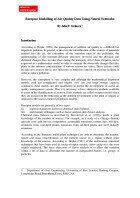Receptor Modelling of Air Quality Data Using Neural Networks
Oct 06 2014
Author: John P. Grubert on behalf of CEM
Introduction
According to Hopke (1991) the management of ambient air quality is a difficult but important problem. In general, it involves the identification of the sources of materials emitted into the air, the estimation of the emission rates of the pollutants, the understanding of the transport-diffusion processes involved and the physical and chemical changes that can take place during the transport. All of these elements can be expressed in a mathematical model in order to compute the observable changes that take place in the airborne concentrations if various actions are taken. These actions could include new sources due to new industries or emission controls on existing facilities in order to reduce pollution.
However, the atmosphere is very complex and although the mathematical dispersion models used are complicated and require very fast and large storage capacity computers, these models are still insufficient to permit the development of useful air quality management systems. Thus it is necessary to have alternative methods available to assist in the identification of sources. Such methods are called receptor models since
they are focused on the behaviour of the ambient environment at the point of impact as opposed to the source-oriented dispersion models.
Receptor models are generally of two types:
(i) regression analyses known as chemical mass balance,
(ii) multivariate techniques such as factor analysis, and cluster analysis.
Chemical mass balance as described by Kowalczyk et al. (1978), needs a prior knowledge of the number of sources. For example, in a study of a Chicago district, aerosols were split into six components: automobile emissions, cement dust, soil dust, emissions from coal-fired plants, emissions from oil-fired plants and steel industry emissions.
According to the literature multivariate techniques are able to determine the number, nature and mass concentrations of the particle source in a region without prior knowledge of the sources. According to Hopke (1981) of the multivariate statistical techniques that have been used as source-receptor models, factor analysis is the most widely employed. The basic objectives of factor analysis is to allow the variation within a set of data to determine the number of independent factors, i.e. groups of particles.
This paper describes an original and alternative statistical approach using backpropagation neural networks which has the same objectives as factor analysis but utilises a completely different technique. The method is therefore valuable as an independent solution for comparison purposes and unlike factor analysis requires no knowledge of statistics.
Receptor modelling using neural networks was applied to air quality data collected from the ambient aerosol in a district of Birmingham in the West Midlands. Sixty-nine fine fraction (dia. < 2.5 mm) and seventy coarse fraction (2.5 mm < dia. < 11 mm) aerosol samples were used in the study, the object of which was to identify and quantify sources of pollution.
For this study the data set consisted of the concentrations (ng/m3) of a large number of metals and anionic species, plus meteorological data such as relative humidity (%), temperature (oC), wind speed (km/hr), solar radiation (W/m2) and daily rainfall (mm). This data was taken over 70 sampling days during the winter of 1990 by Lukana and Harrison (1991), for the fine and coarse data respectively.
The results of the neural network analysis were compared with the factor analysis results obtained by Wormald (1994) using the same data sets. Wormald’s dissertation verified the results of an earlier factor analysis study by Birmingham University. However, the meteorological data was used only in the neural network analysis and not in the factor analysis study. Also, unlike the neural analysis, it was not possible in the factor analysis method used by Wormald to find the mass concentrations of any of the elements only their matrix loading factors.
Digital Edition
Asian Environmental Technology 27.2 - April/May 2023
May 2023
In This Edition Business News - Celebrating The Life Of A Gas Measurement Industry Icon - A New Home For Gas Sensor Specialists - Envea Completes The Acquisition Of Hycontrol Ltd Environ...
View all digital editions
Events
Jul 02 2023 Albena, Bulgaria
Jul 04 2023 Cardiff, UK
Jul 05 2023 Johannesburg, South Africa
Jul 11 2023 Shanghai, China
Jul 11 2023 Lagos, Nigeria















